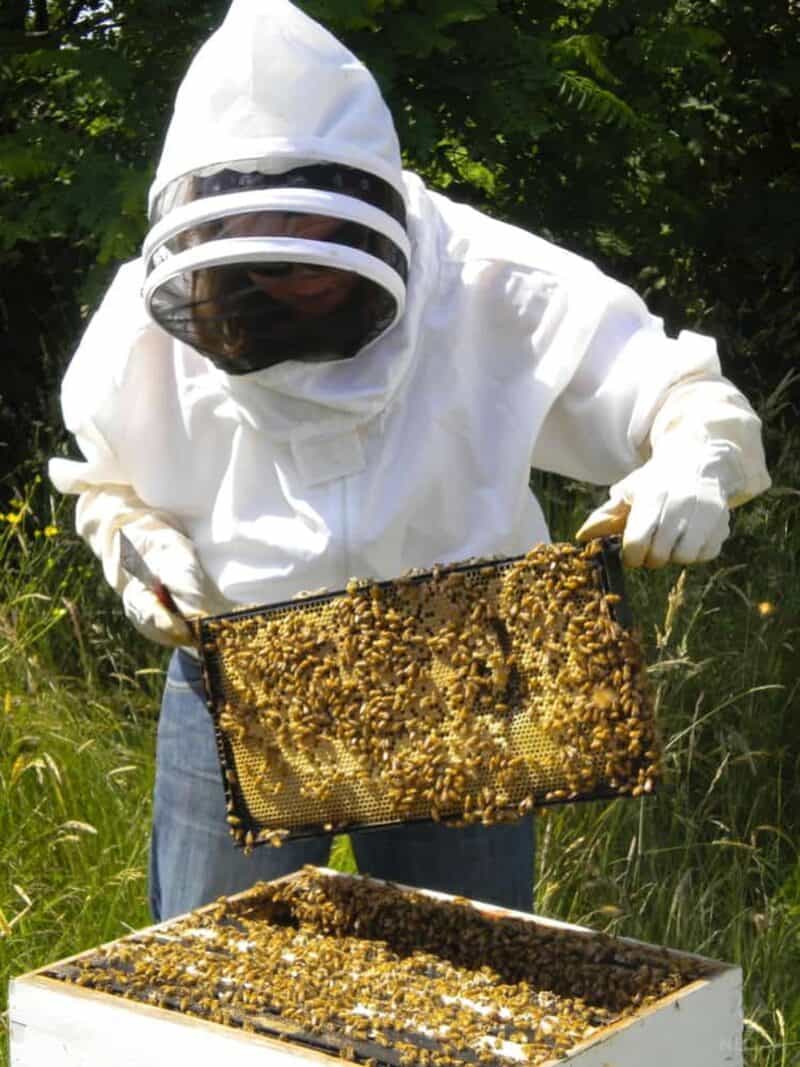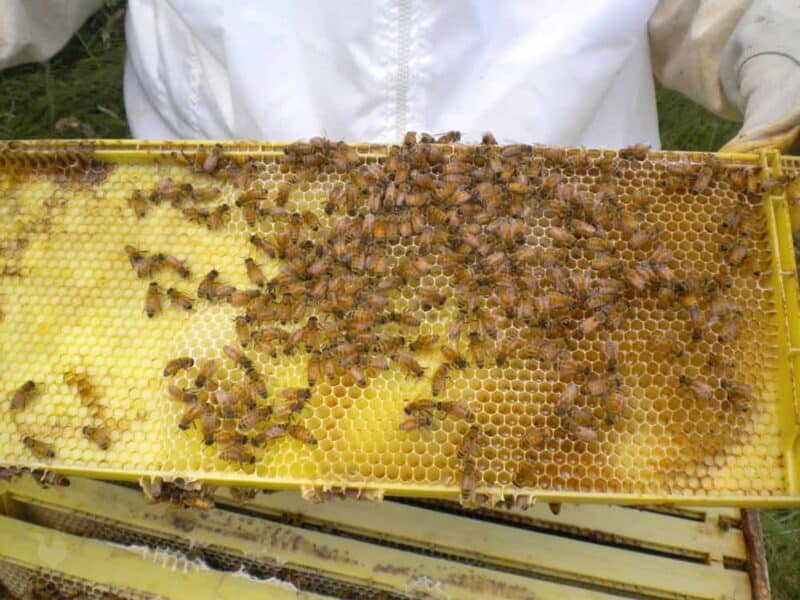Nature furnishes us many examples of excellence in engineering among the members of the animal kingdom.

Beavers change entire ecosystems with their dams. Ants excavate extensive underground colonies.
But probably no other construction has captured the imagination like the humble beehive. The geometric symmetry, the purpose, the sheer coordination required to make one; it’s amazing!
As if you didn’t need any other reasons to like bees, but how do bees make their hives anyway?
The building a beehive starts with scouting a suitable location, then laying down the propolis, a resinous casing from which construction continues. After that, honey is used to make wax which bees chew to shape and build the hexagonal cells that form the hive proper.
Bees have this down to a science, believe me! And whether they’re looking for a new home or a swarm is splitting off from an existing colony, the industrious bees will put together a new and thriving hive and no time flat as long as they have plenty of food.
It’s truly a fascinating process and I have found myself mesmerized by it on more than one occasion.
Keep reading, and I’ll tell you everything you need to know about how bees build their hives…
Every Hive Starts with the Right Location
Before a single dollop of wax is laid for a hive, a suitable location must be found.
In the wild, bees spend quite a bit of time looking for the place that’s just right for their purposes, and this is done by dispatching scouts from the colony or from the swarm that is traveling with the itinerant queen.
Scouts, as effective and industrious as bees ever are, will look for places that check off a variety of boxes for the future colony.
The location must be protected from predators, water, and inclement weather, and it usually takes the form of a crack or split in rock, an opening in a tree or some other location that affords the bees plenty of room to build while still being sheltered.
This location must also be shady, because intense direct sunlight can melt the precious wax that bees depend on to actually build their home.
Lastly, but certainly not least, the location must have ample food nearby, because this is what the bees will depend on both for the production of successive generations and also for generating lots of honey, honey they’ll need to eat and also turn into more wax.
This location found, the scout will report back to the other bees and if consensus is reached they will depart for the new hive location.
Once the Workers Arrive, the Propolis is Laid from Top to Bottom
With the workers arriving at the new hive location, work will begin at once but it doesn’t start with wax.
Instead, it starts with a material called propolis, which serves as the foundation and sometimes outer casing or wall of a hive.
This stuff is distinct from wax, although it’s made with a small portion of wax. It also consists of various collected plant resins and bee saliva and is used the same way we use construction adhesive.
It gives the hive strength, serves as a foundation to build cells upon, and also seals out contaminants and most insect predators.
One fun bit of bee trivia is that bees always work from top to bottom in a given space, so they will start high up in a crevice or opening and then work downward.
With the Propolis in Place, Beeswax is Produced by Workers
With the propolis laid, or at least enough laid to begin construction of cells that is exactly what the bees will move on to next.
But to do that, they’ll need a lot more wax. Beeswax is actually something that the bees make themselves, internally, and this process is as fascinating as the hive construction itself.
Worker bees produce wax themselves by consuming nectar that’s brought in by other bees.
One worker will feed nectar taken from any given flower to another worker bee that is engaged in construction and the liquid content of the nectar will eventually evaporate and then turn into honey.
The workers that are engaged in construction have special glands, developed when a worker bee is only 10 days old, that will use the sugars present in honey and turn them into wax.
This wax is actually secreted through the surface of the bee’s abdomen, and is visible as small scales or flakes.
Workers will take this wax and chew it to make it pliable and shapeable. Then, it can be put to work shaping other features of the hive.
It should be noted that bees are extremely skilled and efficient with their wax, because it takes six units of honey to make one unit of wax, and it already takes a lot of nectar to make just a little bit of honey.
So wax is extremely expensive to bees in terms of overall resources!
Workers Use Their Wax to Make Honeycomb Cells
This brings us to one of the most fascinating and iconic parts of beehive construction: those hexagonal cells.
Cells are multi-purpose compartments in a hive, used to store honey, contain eggs and hatching larvae, and also to stash surplus resources in the form of nectar or wax. An all-in-one solution!
If you’ve ever looked at a honeycomb, you have probably marveled at how precise the layout is, with each cell being the same size and forming a remarkably geometric pattern of hexagonal polygons.
Have you ever wondered why that is?
It’s because the hexagon and the hexagon alone affords maximum storage capacity for the least amount of materials, and it will “tile” infinitely with no wasted space between cells as you would get with cylinders or other shapes.
And unlike squares, hexagons are far more durable and rigid when under load or stress, making the hive more structurally sound and resistant to damage overall.
Truly an amazing facet of hive construction and one of the wonders of nature!
Once a Cell is Built, a Worker will Polish and Clean the Inside
But once that hexagonal cell is finished a worker bee gives it a final pass to polish and tidy up the inside. Only then will she move on to further construction or to other tasks as dictated to her.
This is for a very important reason…
Cells Must be Just Right or the Queen Will Reject Them!
When the queen is coming along to lay an egg in a prepared cell made by a worker, she will first inspect it.
If she determines that anything is not up to her standards in the cell, she will pass it by.
This is because the cell must be clean enough, spacious enough and symmetrical enough to support the egg and keep it safe all the way through the hatching of the larvae, until such time as a new worker bee is ready to emerge.
Suffice it to say the queen has high standards, but it’s still a rarity that any given cell will be rejected assuming it hasn’t been damaged by some external force.
If a cell has been rejected or part of the honeycomb is damaged, all bees have to do to recycle the wax is chew it to soften it and then carry clumps of it away.
No waste, no problems! Remember: wax is a big investment for bees.

Finishing Touches and Expansion
After this point, work will continue like this over and over according to the needs of the colony, growing ever larger.
When the hive is experiencing a boom time with plenty of food and a surplus of honey, bees will build quickly in order to store it.
They will do the same thing when times are good and the queen is cranking out thousands of eggs every single day to increase the colony’s numbers.
But there are a few finishing touches left to take care of, and some odds and ends. A beehive will only have one opening, that is one entrance or all of the bees will enter an exit.
This makes it harder to assault by predators, and to this end bees will lay down a layer of propolis at the entrance.
This acts like a doormat of sorts to help clean contaminants off of the feet of bees returning to the hive, and also an impediment to intruders.
Speaking of intruders, if the bees manage to take out any predators or trespassers inside the hive, assuming they cannot easily drag out the body they will instead entomb it inside a coffin of sorts made from propolis and wax.
This will prevent the decomposition of the vanquished invader from endangering the health of the hive.
Do Domestic Bees Build the Same Way Wild Bees Do?
Generally yes, though they build on frames placed inside hive boxes.
Aside from making the construction of the hive even more regular and symmetrical, bees will build in the same way using the same processes: Layer of propolis from top to bottom, cells constructed from wax, the whole bit.
I like to think that bees definitely appreciate having such a sturdy, safe place to build, and the fact they also have humans watching out for them to keep predators away!
Tom has lived and worked on farms and homesteads from the Carolinas to Kentucky and beyond. He is passionate about helping people prepare for tough times by embracing lifestyles of self-sufficiency.
